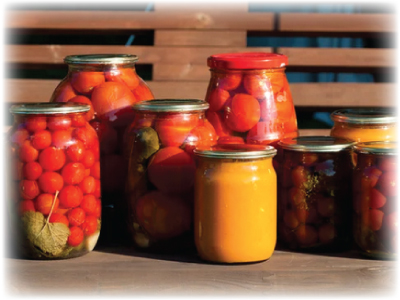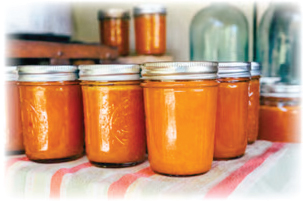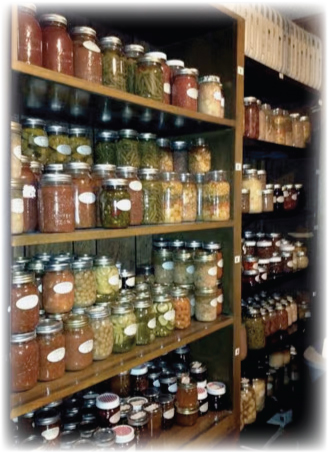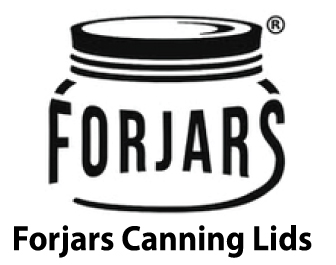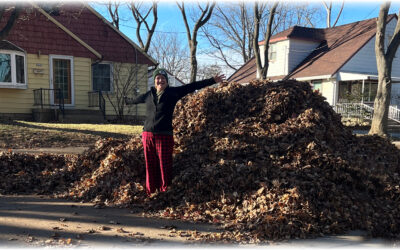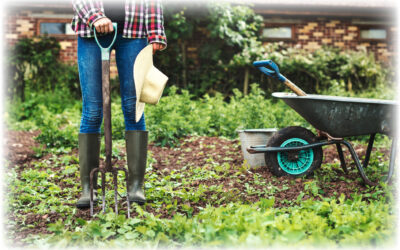Canning
Now more than ever, putting up food had become a way to ensure we can feed our families in these trying times. We have all seen the images of empty store shelves, can canning your own food will give you a reliable source for healthy food, even if the grid goes down, as canned goods don’t require refrigeration.
Once your harvest starts coming in you can become a little overwhelmed with the onslaught of fresh veggies. You can’t eat them all at once! This is where canning can be a very useful tool to add to your preserving arsenal. And even if you aren’t growing all your crops, you can get a lot of reasonably-priced produce at your local farmers markets.
There is nothing like opening a jar of your own canned produce in the middle of winter to bring you back to summer and makes you proud of yourself for learning this new and useful skill.
While your produce usually starts coming in strong at the end of July and through August. you can start to learn the skills needed to save and preserve your harvest for September when the canning will begin.
Types of Canning
There are two types of canning, Pressure and Water Bath. Depending on what you are canning will depend on which type of canning you will do. Water bath canning is very straightforward while pressure canning has more of a learning curve, and many people are apprehensive to try it, but once you learn how to do it safely it’s a breeze. Having the right equipment, which we will talk about is essential.
The National Center for Home Preservation is a great resource to educate yourself on both types of canning and how to do it safely. It is highly recommended that you educate yourself prior to attempting any type of canning and they have a free resource that can be downloaded on their website – USDA Complete Guide to Home Canning. You can also purchase the book with updates here.
Water Bath Canning
Water Bath Canning uses boiling water to preserve the food. This is used for high-acid foods such as tomatoes, salsas, jams, jellies, and some vegetables that have been made more acidic with the addition of vinegar, lemon juice, or citric acid.
Equipment needed for water bath canning is pretty straightforward and you may already have what you need in your kitchen – a pot that can hold your jars that is deep enough to have at least 1 inch of water over the top of your cans, a trivet or rack to keep your jars off of the bottom of the pot (a cake cooling rack, a metal trivet, or even a layer of metal canning bands will do), a funnel to help you fill the jars, a bubble tool to release any air bubbles (a wooden skewer, chopstick or plastic knife will do), and a magnetic lifter to lift the lids out of the hot water (this may not even be necessary as the new lids no longer require this). Thrift stores and garage sales are a great way to find budget-friendly canning supplies, or you can also buy a complete water bath canning kit. (We will receive a small commission if you purchase from this affiliate link at no additional cost to you.)
Pressure Canning
Pressure Canning is for low acids foods (foods having a pH of 4.6 or higher.) which include most vegetables and meats and mixed-acids foods such as soups, chilis, and mixed vegetables. It is not recommended to preserve any dairy products. Pressure canning heats your product to a much higher temperature, ensuring that all bacteria, including Clostridium botulinum, a bacteria that causes botulism is completely deactivated.
There are two types of pressure canners, stovetop or electric. Electric canners have the lowest learning curve but there are some mixed reviews on units not powering up. Stovetop canners don’t have that issue but you still want to get a quality product. Prices range wildly on canners so you may want to look for someone selling them at garage sales, etc.
Pressure canners either have a weighted pressure gauge or both. It is critical to read the instructions for each canner. If you buy a used one you will need to go to the manufacturer’s website and download the manual. Unlike water bath canning, jars do not need to be covered with water. Depending on your canner, you will usually only need 2-3 inches of water. You will insert a rack in the bottom of the canner so jars or not directly in contact with the bottom, insert your prepared jars, affix the lid and start the process. Simply Canning has great instructions on canning with a pressure canner.
Recipes
No matter whether you are pressure or water bath canning, it is very critical that you use an approved recipe to ensure a safe product. Melissa K. Norris is a homesteader that has many great recipes on her website, as well as free e-books you can download.
Resources
Forjars – We have found a great resource for canning lids that are priced reasonably. We have personally tested them and they work great! Use the code HONEYCUTT10 for 10% off your first order!
Facebook has many groups you can join to learn more and ask questions. Here you will find many seasoned canning enthusiasts as well as people new to canning. Just like growing your own food, preserving your food with this method is a lifelong learning opportunity, so embrace it!
YouTube is another great resource to help you in your canning journey. Once you have the basics down and are more comfortable canning, either by water bath or pressure canning, YouTube is a great way to learn how to can a particular food.


